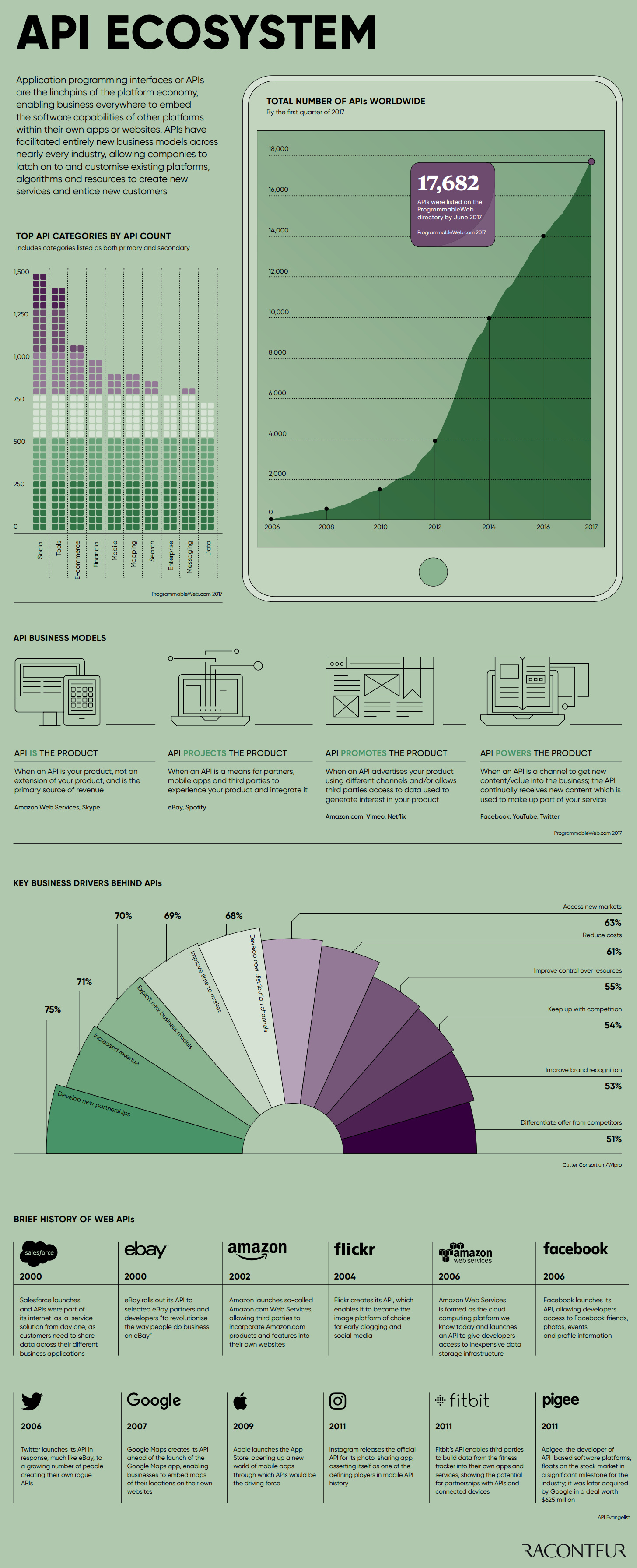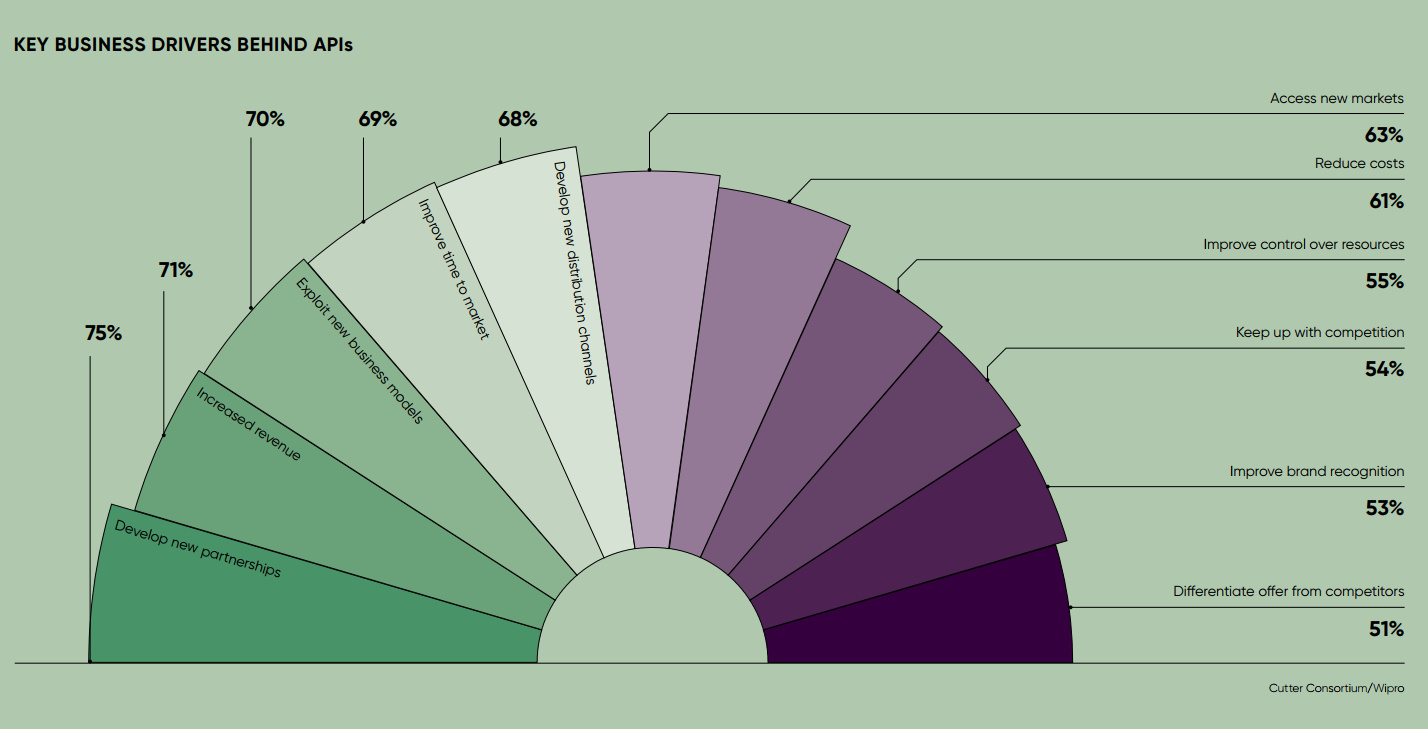Technology
APIs: The Unsung Heroes of our Connected World

APIs: The Unsung Heroes of our Connected World
Connected digital platforms improve our lives in many ways. We use social network profiles to log onto apps and websites, third-party payment systems while online shopping, and we share our activity data from devices like Fitbit. How do all these platforms work together so seamlessly?
It’s all done through a technology known as Application Programming Interfaces (APIs).
As today’s infographic from Raconteur demonstrates, thousands of APIs are allowing companies to work together and share data in powerful ways.
Here are the four main business models that use APIs:
| Business Model | Description | Example Companies |
|---|---|---|
| API is the Product | The API itself is the primary source of revenue | Amazon Web Services, Skype |
| API Projects the Product | Allows partners and third-parties to integrate | eBay, Spotify |
| API Promotes the Product | Advertises your product, shares data to generate interest | Amazon, Vimeo, Netflix |
| API Powers the Product | A channel to drive new data / content onto platform | Facebook, YouTube, Twitter |
How Do APIs Work?
An API is essentially a messenger that delivers a request to the provider you’re requesting it from, and then delivers the response back to you. Here are some of real-world examples:
Travel Sites – If you are using a travel site (e.g. Travelocity, Expedia), APIs are what allow that site to “talk to” airline databases to generate results to your query. Without an API, there would be no way for travel websites to aggregate flight and hotel quotes in real time.
Advertising – If you are a marketer, you are likely using a service to manage your campaigns in one place. Social platforms like Twitter have an API for ads that allows for integration between their platform and selected advertising solutions. This keeps marketers from having to log in to every single social website to manage their campaigns.
Apps – Say you open up a weather app on your iWatch. That app needs to get its information from a source, typically a website like weather.com. Apple could scrape information off the website, but APIs allow a more standardized, stable approach for requesting information. This way, weather.com can dictate the structure of information requests to facilitate the seamless flow of information.
Next time you’re cursing the weather forecast on your phone, remember the hero who fetched the information for you.
Technology
Ranked: Semiconductor Companies by Industry Revenue Share
Nvidia is coming for Intel’s crown. Samsung is losing ground. AI is transforming the space. We break down revenue for semiconductor companies.
Semiconductor Companies by Industry Revenue Share
This was originally posted on our Voronoi app. Download the app for free on Apple or Android and discover incredible data-driven charts from a variety of trusted sources.
Did you know that some computer chips are now retailing for the price of a new BMW?
As computers invade nearly every sphere of life, so too have the chips that power them, raising the revenues of the businesses dedicated to designing them.
But how did various chipmakers measure against each other last year?
We rank the biggest semiconductor companies by their percentage share of the industry’s revenues in 2023, using data from Omdia research.
Which Chip Company Made the Most Money in 2023?
Market leader and industry-defining veteran Intel still holds the crown for the most revenue in the sector, crossing $50 billion in 2023, or 10% of the broader industry’s topline.
All is not well at Intel, however, with the company’s stock price down over 20% year-to-date after it revealed billion-dollar losses in its foundry business.
| Rank | Company | 2023 Revenue | % of Industry Revenue |
|---|---|---|---|
| 1 | Intel | $51B | 9.4% |
| 2 | NVIDIA | $49B | 9.0% |
| 3 | Samsung Electronics | $44B | 8.1% |
| 4 | Qualcomm | $31B | 5.7% |
| 5 | Broadcom | $28B | 5.2% |
| 6 | SK Hynix | $24B | 4.4% |
| 7 | AMD | $22B | 4.1% |
| 8 | Apple | $19B | 3.4% |
| 9 | Infineon Tech | $17B | 3.2% |
| 10 | STMicroelectronics | $17B | 3.2% |
| 11 | Texas Instruments | $17B | 3.1% |
| 12 | Micron Technology | $16B | 2.9% |
| 13 | MediaTek | $14B | 2.6% |
| 14 | NXP | $13B | 2.4% |
| 15 | Analog Devices | $12B | 2.2% |
| 16 | Renesas Electronics Corporation | $11B | 1.9% |
| 17 | Sony Semiconductor Solutions Corporation | $10B | 1.9% |
| 18 | Microchip Technology | $8B | 1.5% |
| 19 | Onsemi | $8B | 1.4% |
| 20 | KIOXIA Corporation | $7B | 1.3% |
| N/A | Others | $126B | 23.2% |
| N/A | Total | $545B | 100% |
Note: Figures are rounded. Totals and percentages may not sum to 100.
Meanwhile, Nvidia is very close to overtaking Intel, after declaring $49 billion of topline revenue for 2023. This is more than double its 2022 revenue ($21 billion), increasing its share of industry revenues to 9%.
Nvidia’s meteoric rise has gotten a huge thumbs-up from investors. It became a trillion dollar stock last year, and broke the single-day gain record for market capitalization this year.
Other chipmakers haven’t been as successful. Out of the top 20 semiconductor companies by revenue, 12 did not match their 2022 revenues, including big names like Intel, Samsung, and AMD.
The Many Different Types of Chipmakers
All of these companies may belong to the same industry, but they don’t focus on the same niche.
According to Investopedia, there are four major types of chips, depending on their functionality: microprocessors, memory chips, standard chips, and complex systems on a chip.
Nvidia’s core business was once GPUs for computers (graphics processing units), but in recent years this has drastically shifted towards microprocessors for analytics and AI.
These specialized chips seem to be where the majority of growth is occurring within the sector. For example, companies that are largely in the memory segment—Samsung, SK Hynix, and Micron Technology—saw peak revenues in the mid-2010s.
-

 Green2 weeks ago
Green2 weeks agoRanked: Top Countries by Total Forest Loss Since 2001
-

 Travel2 weeks ago
Travel2 weeks agoRanked: The World’s Top Flight Routes, by Revenue
-

 Technology2 weeks ago
Technology2 weeks agoRanked: Semiconductor Companies by Industry Revenue Share
-

 Money2 weeks ago
Money2 weeks agoWhich States Have the Highest Minimum Wage in America?
-

 Real Estate2 weeks ago
Real Estate2 weeks agoRanked: The Most Valuable Housing Markets in America
-

 Markets2 weeks ago
Markets2 weeks agoCharted: Big Four Market Share by S&P 500 Audits
-

 AI2 weeks ago
AI2 weeks agoThe Stock Performance of U.S. Chipmakers So Far in 2024
-

 Automotive2 weeks ago
Automotive2 weeks agoAlmost Every EV Stock is Down After Q1 2024














